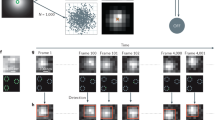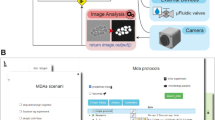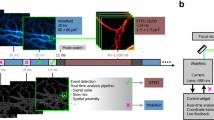Abstract
Quantitative microscopy relies on imaging of large cell numbers but is often hampered by time-consuming manual selection of specific cells. The 'Micropilot' software automatically detects cells of interest and launches complex imaging experiments including three-dimensional multicolor time-lapse or fluorescence recovery after photobleaching in live cells. In three independent experimental setups this allowed us to statistically analyze biological processes in detail and is thus a powerful tool for systems biology.
This is a preview of subscription content, access via your institution
Access options
Subscribe to this journal
Receive 12 print issues and online access
$259.00 per year
only $21.58 per issue
Buy this article
- Purchase on Springer Link
- Instant access to full article PDF
Prices may be subject to local taxes which are calculated during checkout



Similar content being viewed by others
References
Pepperkok, R. & Ellenberg, J. Nat. Rev. Mol. Cell Biol. 7, 690–696 (2006).
Conrad, C. & Gerlich, D.W. J. Cell Biol. 188, 453–461 (2010).
Ramo, P., Sacher, R., Snijder, B., Begemann, B. & Pelkmans, L. Bioinformatics 25, 3028–3030 (2009).
Jones, T.R. et al. Proc. Natl. Acad. Sci. USA 106, 1826–1831 (2009).
Pau, G., Fuchs, F., Sklyar, O., Boutros, M. & Huber, W. Bioinformatics 26, 979–981 (2010).
Held, M. et al. Nat. Methods 7, 747–754 (2010).
Hutchins, J.R. et al. Science 328, 593–599 (2010).
Neumann, B. et al. Nature 464, 721–727 (2010).
Hammond, A.T. & Glick, B.S. Mol. Biol. Cell 11, 3013–3030 (2000).
Neumann, B. et al. Nat. Methods 3, 385–390 (2006).
Wang, M. et al. Bioinformatics 24, 94–101 (2008).
Bird, A.W. & Hyman, A.A. J. Cell Biol. 182, 289–300 (2008).
Schaar, B.T., Chan, G.K., Maddox, P., Salmon, E.D. & Yen, T.J. J. Cell Biol. 139, 1373–1382 (1997).
Muller, K.P. et al. Biophys. J. 97, 2876–2885 (2009).
Schmiedeberg, L., Weisshart, K., Diekmann, S., Meyer Zu Hoerste, G. & Hemmerich, P. Mol. Biol. Cell 15, 2819–2833 (2004).
Forster, R. et al. Curr. Biol. 16, 173–179 (2006).
Erfle, H. et al. J. Biomol. Screen. 13, 575–580 (2008).
Conrad, C. et al. Genome Res. 14, 1130–1136 (2004).
Neumann, B. et al. Nat. Methods 3, 385–390 (2006).
Fan, R.-F., Chen, P.-H. & Lin, C.-J. J. Mach. Learn. Res. 6, 1889–1918 (2005).
Guyon, I., Weston, S., Barnhill, S. & Vapnik, V. Mach. Learn. 46, 389–422 (2002).
Fraley, C. & Raftery, A.E. J. Am. Stat. Assoc. 97, 611–631 (2002).
Neumann, B. et al. Nature 464, 721–727 (2010).
Rabut, G. & Ellenberg, J. in Live Cell Imaging: A Laboratory Manual (eds., R.D. Goldman & D.L. Spector) 101–127 (Cold Spring Harbor Laboratory Press, 2005).
Acknowledgements
This study was technically supported by the use of the European Molecular Biology Laboratory Advanced Light Microscopy Facility and Information Technology Service Unit. We acknowledge C. Chapuis for the CBX1-EGFP BAC cell line expressing H2B-mCherry. This project was funded by grants to J.E. and R.P. (within the MitoCheck, MitoSys and Systems Microscopy consortia) by the European Commission (LSHG-CT-2004-503464, FP7/2007-2013-241548 and FP7/2007-2013-258068), to R.P. by the Landesstiftung Baden-Württemberg in the framework of the research program RNS/RNAi and within the Nationales Genomforschungsnetz-Plus consortium IG-CSG (01GS0865). T.H.T. is financed by the Deutsche Forschungsgemeinschaft Graduiertenkolleg GRK118.
Author information
Authors and Affiliations
Contributions
C.C. developed the 'Micropilot' software and drafted the manuscript. A.W. developed the Visual Basic for Applications macro and performed and analyzed the automatic FRAP experiments. T.H.T. developed the feature selection, extended classification to multiple channels and acquired and analyzed the ERES images. F.V. performed the ERES experiments. J.B. performed and analyzed the spindle length experiments. F.S. and U.L. developed the computer-aided microscopy interface and set up software prototypes. A.E. developed the communication of μManager with Micropilot. T.W. helped with image processing and object feature design. R.P. supervised the project. J.E. supervised the project and revised the manuscript.
Corresponding authors
Ethics declarations
Competing interests
F.S and U.L. filed a patent application covering the CAM approach (Patent Cooperation Treaty/European Patent 2007/059351/US patent application 20100103253). F.S. is employed by Leica Microsystems.
Supplementary information
Supplementary Text and Figures
Supplementary Figures 1–3 and Supplementary Table 1 (PDF 317 kb)
Supplementary Software
Micropilot software source code, documentation, microscope scripts and demonstration images. (ZIP 37024 kb)
Supplementary Video 1
Example video of H2B-tubulin HeLa cells negative control from prophase recognition on. (MOV 1397 kb)
Supplementary Video 2
Example video of FRAP on CBX1-EGFP interphase. (MOV 2493 kb)
Supplementary Video 3
Example video of FRAP on CBX1-EGFP early prophase (slow recovery). (MOV 3780 kb)
Supplementary Video 4
Example video of FRAP on CBX1-EGFP late prophase (fast recovery). (MOV 5121 kb)
Rights and permissions
About this article
Cite this article
Conrad, C., Wünsche, A., Tan, T. et al. Micropilot: automation of fluorescence microscopy–based imaging for systems biology. Nat Methods 8, 246–249 (2011). https://doi.org/10.1038/nmeth.1558
Received:
Accepted:
Published:
Issue Date:
DOI: https://doi.org/10.1038/nmeth.1558
This article is cited by
-
Smart lattice light-sheet microscopy for imaging rare and complex cellular events
Nature Methods (2024)
-
Smart microscopes of the future
Nature Methods (2023)
-
Deep Visual Proteomics defines single-cell identity and heterogeneity
Nature Biotechnology (2022)
-
Enabling reactive microscopy with MicroMator
Nature Communications (2022)
-
Microscopes are coming for your job
Nature Methods (2022)



